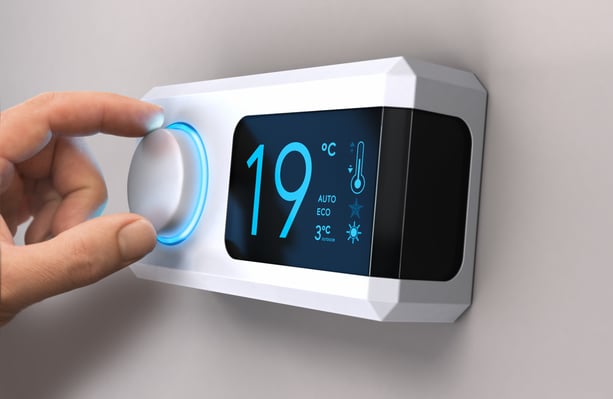Protecting the environment is a major concern nowadays, and companies in all areas of business are adopting environmentally friendly methods and techniques. However, there is also a significant opportunity to reduce the environmental impact of the residential sector.
When green design features are implemented in homes and multifamily buildings, they often bring economic benefits as well. For example, energy efficiency measures reduce electricity and gas bills, while water conservation measures reduce the corresponding water bill. Given that environmental sustainability is gaining importance, these measures can also make properties more valuable on the real estate market.
Reduce your utility bills and carbon emissions with a green building project.
This article provides some recommendations that can reduce the environmental impact of houses, apartments and other residential properties.
Smart HVAC Systems
In most residential buildings, HVAC systems consume more energy than all other appliances. However, a large amount of energy used by HVAC appliances is wasted due to inadequate insulation, leaks in ducts, and air leaks through windows and doors. All of these factors influence the heating and cooling efficiency of a home.
To optimize the amount of energy and performance of HVAC appliances, ensure that the entire building envelope has adequate insulation. Investigate the types of insulation, their pros and cons, and recommended applications. For example, spray foam insulation is suitable for existing properties, but insulated concrete forms (ICF) are more suitable for new construction because they must be embedded in walls.

Other steps to improve HVAC performance include weatherproofing around doors and windows and replacing windows and doors with newer, more efficient versions. If this is not possible, tints can be added to windows to reflect UV rays and reduce heat transfer.
Efficient Lamps
Everyone has light fixtures in their home, so one of the first things any homeowner should do is replace all inefficient incandescent bulbs with newer, more efficient versions. LED bulbs are recommended as they last longer than incandescent bulbs and consume only a fraction of their energy consumption. Long-lasting bulbs also produce less landfill waste since there is no need to replace them at short intervals.
Renewable energy sources
By definition, renewable energy comes from sources that are naturally replenished, such as sunlight and wind. Unlike fossil fuel reserves, which can be depleted, these resources remain available in the future, regardless of current use. For example, sunlight remains available regardless of how many solar panels are currently installed.
The sun is a powerful natural source of energy that can be obtained through solar panels. Although their initial cost may be high, the long-term cost of ownership is very low. High-quality solar panels have a very long lifespan of over 25 years and can adapt to almost any property whose available space is not covered by shadows.

Other sources of renewable energy include wind energy, biomass, hydroelectric energy and geothermal energy. These are more difficult to implement in a residential building, but you can ask your electricity supplier about the energy sources that power your home. Small wind turbines may be viable in some cases, but they lack the versatility of solar panels.
The main disadvantage of wind and solar energy is their intermittent nature, as the energy input cannot be controlled. However, this will begin to change as the price of energy storage systems decreases. Hydroelectric installations can provide electricity on demand if they have a reservoir to store water, but they are only viable under specific site conditions. Additionally, individual property owners will rarely have the opportunity to use hydroelectric power directly unless the property has a small river flowing through.
Water-efficient accessories
Reducing water use is beneficial for the environment and your electricity bill. Some cities have lawn watering restrictions and programs to reduce water use. There are many home water conservation features that can be incorporated, such as low-flow faucet adapters and efficient toilets. Practices such as smart irrigation and rainwater harvesting can also be adopted to save water and money, while generating a positive environmental impact.
Local building materials
Locally sourced materials should be your first choice for both new construction and major renovations. This reduces transportation costs, minimizing the carbon footprint of the construction process. Wood, aggregates and masonry are usually easy to find and represent the largest portion of materials in residential construction.
In addition to opting for local materials, consider reusing and recycling. By doing this, less construction waste ends up in landfills.
General Recommendations
You should look for the ENERGY STAR label when purchasing any appliance that uses electricity or gas, and the WaterSense label for plumbing fixtures. Both programs are managed by the US Environmental Protection Agency and products are only labeled after a rigorous testing procedure by an independent laboratory – manufacturers cannot label products themselves.

Another way to make home appliances more efficient is through smart technology. Some appliances have built-in controls that optimize efficiency, helping users reduce energy consumption. There are also external devices like smart thermostats to be used when appliances only have basic controls.
Conclusion
By ensuring your home is environmentally friendly, you:
- Reducing your carbon footprint.
- Helping to sustain natural resources.
- Saving money on utility bills.
In an ideal scenario, all buildings should achieve net-zero energy consumption and emissions. Energy-efficient appliances, HVAC techniques, water conservation, green practices and renewable energy sources have gained popularity in recent years. Green measures in your home contribute to the common goal of environmental protection and sustainable construction.

